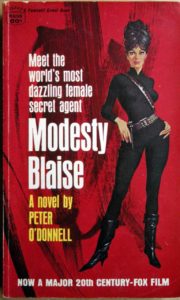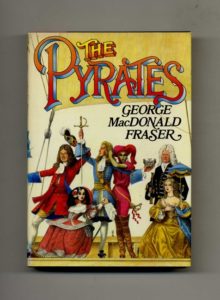
By Vikas Datta
 Given how monotonous and mundane the daily existence of most of us can be, action in its various cultural manifestations is a pleasure, giving us the vicarious experience of lives lived fast and dangerous. For good measure, the sphere is also one where there has been gender equality right from the very beginning.
Given how monotonous and mundane the daily existence of most of us can be, action in its various cultural manifestations is a pleasure, giving us the vicarious experience of lives lived fast and dangerous. For good measure, the sphere is also one where there has been gender equality right from the very beginning.
In literature, however, there are far fewer double standards. Action heroines, who are usually the polar opposites of the ‘Damsel in Distress’, slowly rose from a rare subversion of what was socially acceptable to become a norm.
Figuring in more than the usual woman versus woman fight, aimed mostly at titillating a section of readers (male adolescents mainly, but some older one too), these characters developed from just being the hero’s supporter to becoming someone who, on her own, could face dangerous foes and deadly obstacles — and win.
Action heroines come in various sizes and shapes, ranging from the “Action Fashionista” to the “Action Girlfriend” to the “Warrior Princess”, from the “Cute Bruiser” to the “Pirate Girl”, and from the “Damsel out of Distress” to the “Girls with Guns”, and more.
They are the staple of comics, which lend themselves well to their depiction. But though comics have progressed as far as characterisation and plot go, prose still holds an edge in overall portrayal, as it leaves much to the readers’ imagination.
Most action heroines appear usually in mythology, fantasy (eg, Rick Riordan’s Percy Jackson series) or science fiction, but they also have their ‘real world’ counterparts. For most, Steig Larsson’s Lisbeth Salander would be the most familiar, though not a prepossessing, being “an unusual kind of sociopath”.
 Let us now look at some other examples, beginning with the sultry, stunning and superlatively intelligent Modesty Blaise, who, in the words of Jennifer K. Stuller in “Ink-Stained Amazons and Cinematic Warriors: Superwomen in Modern Mythology”, is the “most complex, sophisticated, skilled and intelligent of all action heroines”.
Let us now look at some other examples, beginning with the sultry, stunning and superlatively intelligent Modesty Blaise, who, in the words of Jennifer K. Stuller in “Ink-Stained Amazons and Cinematic Warriors: Superwomen in Modern Mythology”, is the “most complex, sophisticated, skilled and intelligent of all action heroines”.
Peter O’Donnell’s raven-haired, high-cheekbones and buxom but fighting fit character has had an enviable cross-media stint. Apart from the long-running (1963-2002) globally syndicated comic strip, Blaise stars in 13 books, at least two films, many radio dramas and a number of pop songs.
A TV series, however, didn’t materialise and Quentin Tarantino, who planned to make a film, only ended up showing his “Pulp Fiction” assassin Vincent Vega (John Travolta) reading one of the Modesty novels.
There is plenty of action and sex (Modesty even has a distraction combat gambit of entering a room of enemies topless), vivid characters, including thoroughly dastardly villains, and intricate plots — but so do many others.
But what sets it apart is her close, platonic relationship with her aide, Willie Garvin, based on complete openness, understanding and trust — and so devoted that threatening one will draw the other’s unflinching wrath (as many villains learn). It is this that gives this series its special allure.
Thursday Next, the heroine of Jasper Fforde’s uproarious meta-fiction alternate history, comic fantasy series, is another action heroine, who saves both the worlds she inhabits. She also manages to marry the love of her life, saves him from non-existence, and goes on to raise a family.
Living in a world where England is now a republic, time travel, cloning and genetic engineering exist (dodos are common pets and Neanderthals have been resurrected), but computers or jet aircraft don’t, a shadowy corporation exerts great influence, and literature is revered — and has a special police force at its disposal (where she works); she also operates in the “Bookworld”.
This is a dimension within literature where all books are “constructed” and also house the characters who, well aware they are in a book, act out their roles when being read but live their own lives the rest of the time.
And both are beset by problems — which our plucky heroine manages to resolve.
Nordic noir/Scandinavian noir, which combined crime with trenchant social commentary, emerged with a bang around the 1990s, though it had been around since the 1960s, and it was expected that it would soon boast of a female principal protagonist.
 Swedish nurse-turned-author Helene Tursten’s Inspector Irene Huss fills the gap — with a difference.
Swedish nurse-turned-author Helene Tursten’s Inspector Irene Huss fills the gap — with a difference.
A former jiu jitsu champion, a mother of twin teenage girls, and the wife of a successful chef, Huss is a Detective Inspector in the Violent Crimes Unit in Sweden’s Goteborg.
In her 10-odd appearances, she goes on to solve crimes among the upper crust, inexplicable murders at a hospital, or the massacre of a pastor’s family, confronts skinheads, organised crime, serial killers, human traffickers, and more.
What sets this series (published in English 2003-17) apart from others of its genre is that it acknowledges society’s dark underside — a staple of the modern crime novel — as a danger that must be confronted. The protagonist is an ordinary person who is a cop, not a crusader, and just wants to improve her world a little bit at a time, instead of revelling in the abyss.
And as the bad must be featured along with the good, let’s meet Sheba the She-Wolf from the irrepressible George MacDonald Fraser’s “The Pyrates” (1983), in which he tried to combine every single pirate adventure story — and succeeded.
Full of all possible, tropes stereotypes and deliberate anachronisms, it stars a model classic hero, Captain Benjamin Avery of the Royal Navy, complemented by a bevy of damsels in distress, a charismatic anti-hero, a hilariously malevolent Spanish Viceroy, and six pirate chieftains — Calico Jack Rackham, Black Bilbo, Firebeard, Happy Dan Pew, Akbar the Terrible and Sheba the She-Wolf.
And it is Sheba who “had clawed her way to power in the Coast fraternity by a piratical genius and ruthless ferocity that had made her the toast of women’s liberationists all along the Main”.
“Six gorgeous feet she was, from the heels of her tight-fitting Italian thigh boots (from Gucci, undoubtedly) to the curling plume of her picture hat, breached and shirted in crimson silk that clung to her like a skin, lithe and sleek and dangerous as a panther — Sheba, the black pirate queen, looking like something out of Marvel Comics with her lovely vicious face and voluptuous shape, her dark eyes flashing against her ebony skin, smouldering silently as she unsheathed her dainty rapier with its Cartier hilt, and posed with the contemptuous grace of a burlesque star, indifferent to the ecstatic sighs and groans of her besotted followers.”
Enough said?
Sir Terry Pratchett was known to create strong woman heroines in all his “Discworld” arc of fantasies, but he created the ultimate action heroine in “Good Omens” (1990), co-authored with Neil Gaiman.
“The red haired woman in the corner of the hotel bar was the most successful war correspondent in the world. She now had a passport in the name of Carmine Zuigiber; and she went where the wars were. Well. More or less. Actually she went where the wars weren’t. She’d already been where the wars were.”
We later learn that she is one of the Four Horsemen of the Apocalypse — it is evident which one.
Finally, let’s return to comic book superheroines — but with a difference.
Austin Grossman’s novel “Soon I Will Be Invincible” (2007) is an uninhibited but affectionate parody of both the Marvel and the DC universes.
Here, we see the superhero group ‘New Champions’ taking on the super-strong, super-villain Dr Impossible (who suffers from Malign Hypercognition Disorder or evil genius syndrome) and is making his 13th attempt to take over the world after yet another jailbreak.
There is a problem, however. Their strongest member, and the greatest superhero, CoreFire, is missing. Enjoy the antics of all the superheroes / heroines and the super villains, but keep an eye on Lily, a former group member claiming to be a resident of the future, sent back to avert an ecological disaster. Any more will be spoilers.
(IANSlife)